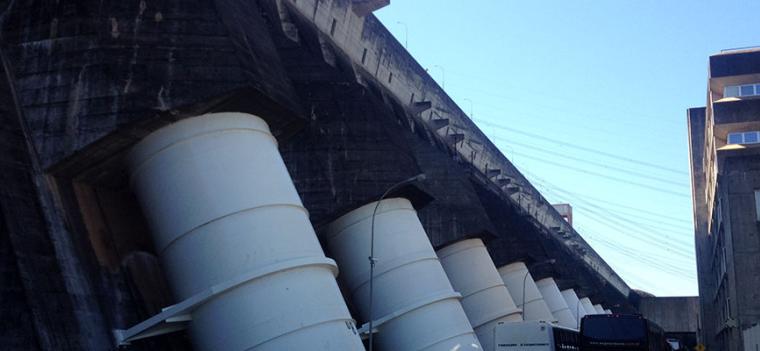News
- With tremendous power needs, India has ambitious plans of expanding electricity generation through solar and wind energy.
- A delegation of senior Indian power sector officials recently visited Brazil on a World Bank-supported study tour to learn from the Brazilian experience of scaling up renewable energy in the power system.
- The knowledge exchange is intended to help India apply best practices from Brazil on the planning, regulation, and execution of integrating variable renewable energy into the grid and pave the way for future collaboration between the two countries.
With among the largest installed power capacities in the world but with rapidly growing energy needs, India has embarked on an ambitious program to vastly expand wind and solar electricity generation. The country aims to have 100 GW of installed solar generation capacity and 65 GW of wind capacity by 2022. Integrating variable renewable energy sources at such a huge scale into an overburdened transmission system will require an overhaul of existing planning, operational, and regulatory practices. The experiences of other countries hold valuable lessons to help facilitate India’s transition.
Brazil has for decades operated a power system with significant levels of renewable energy—mainly hydro, but in recent years with increasing amounts of wind—based on a very particular planning and market model. With support from two World Bank trust funds—the Asia Sustainable and Alternative Energy Program (ASTAE) and the Energy Sector Management Assistance Program (ESMAP), an Indian delegation of senior power sector officials visited Brazil on a study tour from May 17–22, 2015, to investigate the Brazilian experience of scaling up renewable energy in the power system.
“Three areas of particular interest to our delegation were Brazil’s energy planning with increasing levels of renewable energy, their use of auction schemes for renewable energy, and integration of variable renewable energy in Brazil’s transmission grid,” said Tarun Kapoor, Joint Secretary of the Ministry of New and Renewable Energy and head of the Indian delegation to Brazil. “Within the coming one or two decades, both the Indian and Brazilian power sectors will evolve rapidly from relying almost solely on hydro and coal-fired power generation to handling large amounts of solar and wind energy. Very few countries in the world can expect to see a similar absolute growth of variable renewable energy capacity. This knowledge exchange will help India learn from Brazil’s challenges and successes and pave the way for future collaboration.”
The Indian delegation met with key actors in the Brazilian energy sector including the Centro de Pesquisa de Energia Elétrica (CEPEL), the largest electrical energy research institution in South America; the Ministry of Mines and Energy and Empresa de Pesquisa Energética, government agencies that implement sectoral policies on energy and mining; the Conselho Nacional de Política Energética, which defines national energy policies; and the Agência Nacional de Energia Elétrica, which provides regulatory oversight.
Brazil’s integrated and cooperative approach to power system planning is key to maintaining a high quality power supply. Empresa de Pesquisa Energética is officially responsible for developing the 10-year plan for power generation, but all institutions participate in the planning process and provide valuable input. For example, CEPEL contributed models and scenarios for hydro generation, and Operador Nacional do Sistema Elétrico, the national transmission system operator, provides expertise on the transmission capacity. The comprehensive, centralized, and integrated approach to generation and transmission planning is necessary since most large hydroelectric projects are located far from the major load centers and require long, high-voltage transmission systems to transport large amounts of energy during the rainy season and small amounts during the dry season.
Brazil has also developed a unique electricity market model based on long-term contracts awarded through auctions. While most market models are based on short-term contracts, the long-term contracts obtained in the Brazilian auction system create the incentives and security necessary for investors to finance cheap, but capital-intensive renewable energy technology and build the required capacity indicated in the 10-year plan. To ensure an optimal energy mix and create a market for renewable energy technologies such as wind and solar power, the Brazilian auction model covers both existing and new generation through separate auctions for all larger generation technologies.
Because of Brazil’s careful planning, by 2050 the bulk of its energy needs could be met by wind and solar, as hydropower expansion reaches its limit. During a field visit to the Itaipu Hydropower Plant, the Indian delegation learned how Brazil could benefit from this diversification of the generation mix. Since high winds, strong solar irradiation, and the sugarcane harvest coincide with the dry season, increasing levels of wind, solar, and biomass plants in the future may compensate for lower hydropower generation during extended dry spells. Wind and solar power show strong complementarity in Brazil, meaning when one resource is less available, the other is more abundant. Hydropower reservoirs can be used as huge batteries, as excess wind and solar power is used to save and thus accumulate water to reservoirs, thereby reducing the need for back-up capacity.
The Indian delegation also showed particular interest in the remarkable results achieved through the Brazilian auction system. Prices in Brazil have fallen to $50 per MWh for wind and $87 per MWh for solar in recent years – among the lowest worldwide and well below Indian price levels.
As a direct result of the study tour, the Indian and Brazilian government are now working on a Memorandum of Understanding to increase their cooperation on market, planning, and operational measures to facilitate integration of variable renewable energy in the transmission grid. The first target is to have an exchange of technical experts between the two countries within the next year.
Learn more about the ESMAP Clean Energy program.
